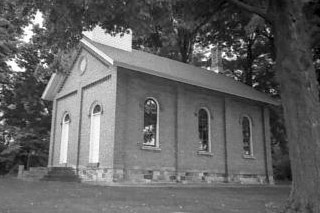There are many ways in which you can connect with your ancestors. You might look at old photographs, read family history documents, listen to stories told by your relatives, and more. Have you ever thought, however, about how archaeology can help you understand the past and make that connection?
Archaeology is the study of past lifeways, cultures, and the investigation of what items people have left behind. Cultures are studied which may take us back in time hundreds of years, and archaeologists analyze things that you might not have even thought of or learned about!

One-room schoolhouse
Perhaps some relatives have talked about what it was like to attend a one-room schoolhouse. Can you imagine going to a school with just a few fellow students and learning all together in one room? Archaeologists record one-room schoolhouses that might still exist, and their investigations can tell us about the activities which took place and what types of items the students might have used. We can, therefore, compare how today’s learning environment might have differed from that of the past.
Have you ever heard your relatives talk about the way things used to be? Has Grandma ever shared with you the types of toys that she used to play with? Archaeological investigations help us learn how things have changed, and perhaps how things have stayed much the same in terms of our everyday items.

Pieces of dolls from the 1900s
Photo courtesy of Paul Mullins
Some things from the past might have been discussed with you, but maybe you don’t know much about them. For example, when you hear about outhouses or a privy, do you know what that means? Many young people today might not realize that for many, many years, houses didn’t have bathrooms in the actual house! Try and imagine that if you had to go to the bathroom, you needed to go outside to find the “little house out back.” Archaeologists sometimes discover lots of information from digging in places even such as these! Within the soil that was used as fill was a good deal of interesting artifacts that fell or were thrown in. It is not always the glamorous type of adventure that you might see in movies, but the science of archaeology can help us appreciate even the secrets that unusual places have to share.
Think about wanting to wash your hands. Hundreds of years ago, you might have had to gather your water from a brick-lined well in the backyard. What happened though, when the well was no longer needed? Often it was filled in with dirt, and trash and the items which were deposited there can now lead archaeologists to tantalizing clues about the everyday lives of our ancestors. The archaeologist in this picture is down in an excavated well handing out items that were found at the bottom.
Try and connect your past with the present. Visit an archaeological investigation and actually help with the activities which will be happening at a “dig.” Piecing together the puzzle of the past is important, and can help us understand the world in which your ancestors lived!

Items are recovered on a dig in a well
Photo courtesy of Paul Mullins
To learn more about archaeology, and how you can become involved, get your parents’ permission to visit the following web pages:
